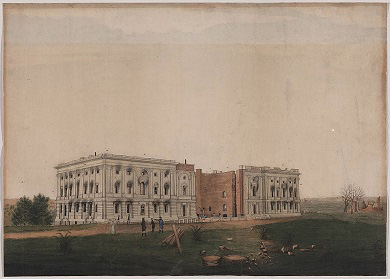When the British captured Washington, they wanted revenge for the destruction of towns in Upper Canada. They set fire to public buildings throughout the city, and looted the President’s House. It remains the only time in American history that a foreign nation had captured and burned the capital.
“to complete the destruction of the public buildings with the least possible delay” British Major-General Ross’s instructions to Earl Bathurst, August 30, 1814

Library of Congress, Prints and Photographs Division
On August 20, 1814, a British army landed at the town of Benedict on the Patuxent River. Their goal was to capture the American capital city. They reached Bladensburg, just five miles from Washington, on August 24. Across the Potomac, the American army occupied defensive positions with artillery to cover the only bridge leading to the capital. The encounter between these two forces would lead to one of the most memorable episodes of the war: the wholesale destruction of the American capital.
The American defenders outnumbered the British two to one. But they could not withstand the British artillery and rocket bombardment. As the Americans withdrew toward Washington, the British advanced.
In the city, residents prepared to flee or braced for invasion. In the President’s House, Dolley Madison oversaw the evacuation of the house and ordered the rescue of a famous portrait of George Washington.
Residents of Washington were warned that public stores and navy supplies would be burned if the British approached the city. The American Commander, Thomas Tinghey, had orders to prevent any important material from falling into British hands.
Tingey recorded his dilemma in a letter to the Secretary of War: “A deputation also of the most respectable women came” to plead with him, he wrote, but he assured them “that if left at peace, I would delay the execution of the orders as long as I could feel the least shadow of justification.” He delayed as long as he dared, but as darkness fell, his men put torches to the public stores, destroying the Americans’ own supplies.
The British did not plan to stay long in Washington, but wanted revenge for burnings in Canada. Major-General Robert Ross decided it was necessary “to complete the destruction of the public buildings with the least possible delay, so that the army might retire without loss of time.”
British soldiers quickly set fire to “the capitol, including the Senate-house and House of Representation, the Arsenal, the Dock-yard, Treasury, War-office, President's Palace, Ropewalk, and the great bridge across the Potomac,” according to Ross. The fires spread and burned some of the houses nearby public buildings. Looters also took the opportunity to raid homes during the confusion. After only one day of occupation, Washington suffered $1 million in losses and took nearly four years to rebuild.
Last updated: May 24, 2016
